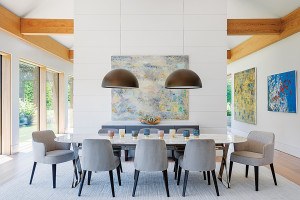Dawn of an Artful Age

Photo by Jared Leeds
If someone were to write your biography, what would the title be?
A great friend once told me that I charge through life as if I were in the Middle Ages, carrying a pennant with the slogan: “I expected more.” That’s not quite my style. I think my biography’s title would be something like More Than One Way.
Really? Tell us more.
It has to do with my operational number: 11. I make big moves every 11 years. I’m the 11th president. And my office is on the 11th floor. It’s also the roman numeral for two, and that’s how I understand the world: through the verbal and visual, text and image. I have twins. I’m a Gemini. There’s this dualism—a balance equation—that figures strongly in my work and life.
You’ve lived just about everywhere. How has that shaped your thinking?
Living abroad has helped me understand how design works in a social, political, and economic way. In the Netherlands the arts are very much a part of the economy—not just understood as some luxury layer on top. Design, architecture, art—it’s all part of the country’s infrastructure.
How will your life experiences inform your work at MassArt?
MassArt is unique because we’re the only public, free-standing state college of art in the U.S. If there were one place in this country that could potentially forge the intersection of art, society, economy, and culture in a civic structure, MassArt would be it. We’re closer to the European model of education than any other school in the country, and my goal is to reposition the institution in the international realm.
Wow. You might need some superpowers to do that! Speaking of which, do you have any?
Well, I do have a magic wand.
Does it work?
Not exactly. My students made and presented me with a colorful staff for the pageant during my presidential inauguration. This is as close as I will come to a magic wand. When people ask me to do the impossible, I can no longer say, “I’d love to do that but I’ve lost my magic wand.” The challenge is now how to use that magic wisely.
When it comes to fashion, what’s your favorite color?
Black—with a red accent. Black is the most stylish color, but it’s also ceremonial. It looks good on most everyone, it hides a multitude of sins, and it doesn’t show dirt. It’s versatile and goes with everything.
And the touch of red?
That’s just so people don’t think I’m a priest. Also, in printing history, black
and red were the colors. If you were going to add one color, it would be red, since that stands out the most and is still legible. Black and red have had this organizational relationship for hundreds of years!
What else has influenced you, personally and professionally?
My husband, R.D.E. Oxenaar. He’s worked as an artist, a designer, a commissioner, and a teacher. Seeing him do it all—and all successfully—in the public and private sector has been extremely inspiring.
Tell us a little about how you see Boston.
New England has a deep historical sensibility. It’s eclectic, polymorphic, and has many layers, because it draws from a great number of resources, people, and areas. But what Boston is lacking is a sense of its “art identity.” Rather than being cohesive, the arts are divided into separate entities: fine arts, design, architecture, music. There’s no galvanizing force. And it’s not for lack of size or quality or inventiveness—it’s for lack of seeing it, embodying it, and establishing that identity.
You grew up in Massachusetts and got your degree at UMass Amherst. What’s the most exciting part of your return?
Even though this is a return, I still consider myself somewhat of an outsider. I relish being a newcomer because it gives me fresh eyes. I see certain things that I don’t know if I’ll see after five years. And what I see now is that Boston has great cultural potential. From the beginning, it’s been a hub of ideas. I’m hoping to see Boston integrate its solid knowledge economy with our burgeoning creative economy and create something really special.
If your house were on fire, what would you grab?
My journals. 59 volumes. And my husband’s, too.
What’s in them?
Mostly writing, although there’s also a lot of diagrams, lists, sketches, and drawings—they’re where my ideas are hatched, where meaning is made. I find that sometimes, through writing, you make more meaning than you even understand yourself. Then when you revisit the journal years later, you realize you weren’t just writing a description—you were writing a poem.


